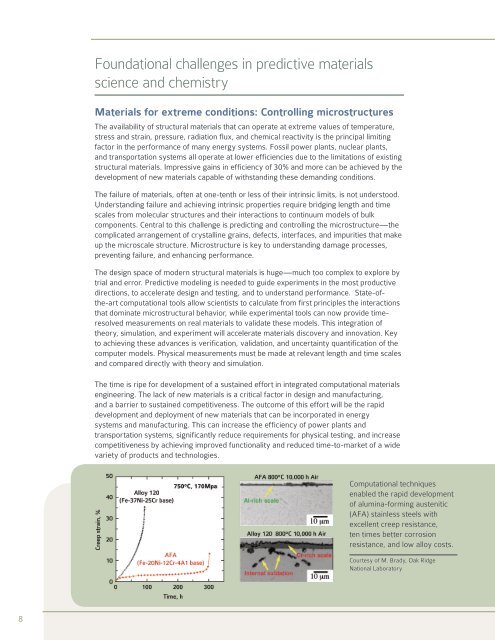Computational Materials Science and Chemistry ... - Office of Science
Computational Materials Science and Chemistry ... - Office of Science
Computational Materials Science and Chemistry ... - Office of Science
Create successful ePaper yourself
Turn your PDF publications into a flip-book with our unique Google optimized e-Paper software.
8<br />
Foundational challenges in predictive materials<br />
science <strong>and</strong> chemistry<br />
<strong>Materials</strong> for extreme conditions: Controlling microstructures<br />
The availability <strong>of</strong> structural materials that can operate at extreme values <strong>of</strong> temperature,<br />
stress <strong>and</strong> strain, pressure, radiation flux, <strong>and</strong> chemical reactivity is the principal limiting<br />
factor in the performance <strong>of</strong> many energy systems. Fossil power plants, nuclear plants,<br />
<strong>and</strong> transportation systems all operate at lower efficiencies due to the limitations <strong>of</strong> existing<br />
structural materials. Impressive gains in efficiency <strong>of</strong> 30% <strong>and</strong> more can be achieved by the<br />
development <strong>of</strong> new materials capable <strong>of</strong> withst<strong>and</strong>ing these dem<strong>and</strong>ing conditions.<br />
The failure <strong>of</strong> materials, <strong>of</strong>ten at one-tenth or less <strong>of</strong> their intrinsic limits, is not understood.<br />
Underst<strong>and</strong>ing failure <strong>and</strong> achieving intrinsic properties require bridging length <strong>and</strong> time<br />
scales from molecular structures <strong>and</strong> their interactions to continuum models <strong>of</strong> bulk<br />
components. Central to this challenge is predicting <strong>and</strong> controlling the microstructure—the<br />
complicated arrangement <strong>of</strong> crystalline grains, defects, interfaces, <strong>and</strong> impurities that make<br />
up the microscale structure. Microstructure is key to underst<strong>and</strong>ing damage processes,<br />
preventing failure, <strong>and</strong> enhancing performance.<br />
The design space <strong>of</strong> modern structural materials is huge—much too complex to explore by<br />
trial <strong>and</strong> error. Predictive modeling is needed to guide experiments in the most productive<br />
directions, to accelerate design <strong>and</strong> testing, <strong>and</strong> to underst<strong>and</strong> performance. State-<strong>of</strong>the-art<br />
computational tools allow scientists to calculate from first principles the interactions<br />
that dominate microstructural behavior, while experimental tools can now provide timeresolved<br />
measurements on real materials to validate these models. This integration <strong>of</strong><br />
theory, simulation, <strong>and</strong> experiment will accelerate materials discovery <strong>and</strong> innovation. Key<br />
to achieving these advances is verification, validation, <strong>and</strong> uncertainty quantification <strong>of</strong> the<br />
computer models. Physical measurements must be made at relevant length <strong>and</strong> time scales<br />
<strong>and</strong> compared directly with theory <strong>and</strong> simulation.<br />
The time is ripe for development <strong>of</strong> a sustained effort in integrated computational materials<br />
engineering. The lack <strong>of</strong> new materials is a critical factor in design <strong>and</strong> manufacturing,<br />
<strong>and</strong> a barrier to sustained competitiveness. The outcome <strong>of</strong> this effort will be the rapid<br />
development <strong>and</strong> deployment <strong>of</strong> new materials that can be incorporated in energy<br />
systems <strong>and</strong> manufacturing. This can increase the efficiency <strong>of</strong> power plants <strong>and</strong><br />
transportation systems, significantly reduce requirements for physical testing, <strong>and</strong> increase<br />
competitiveness by achieving improved functionality <strong>and</strong> reduced time-to-market <strong>of</strong> a wide<br />
variety <strong>of</strong> products <strong>and</strong> technologies.<br />
<strong>Computational</strong> techniques<br />
enabled the rapid development<br />
<strong>of</strong> alumina-forming austenitic<br />
(AFA) stainless steels with<br />
excellent creep resistance,<br />
ten times better corrosion<br />
resistance, <strong>and</strong> low alloy costs.<br />
Courtesy <strong>of</strong> M. Brady, Oak Ridge<br />
National Laboratory

















